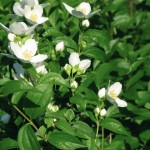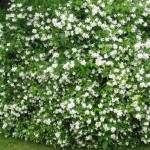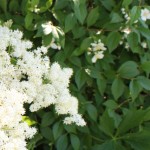Sweet Mock Orange
Sweet Mock Orange produces petite, white, citrus-scented flowers featuring four petals and lemon-yellow stamens. In size, these delicate flowers range between about two and a half to five centimetres across (one- to two-inches). The Sweet Mock Orange shrub (Philadelphus coronarius L.) produces its show of flowers once each season over a three-week period. As with many other spring and early summer flowering plants, the bloom period may feel a bit fleeting. I think it is worthwhile, though, to dedicate space to this beautifully scented shrub in the home garden.
Blooming periods in the northern garden are a bit delayed compared to the mid-May to early June time frame typical for this shrub’s flower display in warmer zones. Here in my North American zone 3b garden, blossoms appear for about three weeks in June, overlapping for a week or so with June-blooming Japanese Tree Lilac.
The genus Philadelphus is a member of the Hydrangaceae family. There are 38 species within the genus Philadelphus. Many of these originate in southern Europe and Austria, and further south to Italy. There are also species native to North America, south to Mexico, and located in temperate to sub-tropical climate zones in Asia.
Of benefit to home gardeners, Sweet Mock Orange requires very little care. I lightly prune my Mock Orange each season, occasionally taking a few of the branches down to the ground, but mainly just trimming the length off some of the branches that get carried away and push out beyond the usual extension. The branches are somewhat arching and a bit droopy, which creates an attractive effect when the Mock Orange is covered with its elegant single-petal blossoms.
Sweet Mock Orange grows well in prairie clay soil. It is, I’m grateful to say, almost bug free. It hasn’t attracted aphids, as some of the species are described as doing. I do, however, get a very minor showing of leaf miners each spring. This situation is easily remedied by spending an hour and a bit hand-picking the tunnelled and blackened leaves to control the bug population and remove the damaged leaves. Apart from this insignificant amount of annual TLC, this lovely species is trouble-free, drought tolerant, partly shade tolerant, and, most importantly, unaffected by the cold winter temperatures of northern gardens.
As a kid growing up on river property, our large yard had a couple of “fields of play” where at various times we set up croquet courses, badminton nets, and Hot Ball bases. Those of us in the neighbourhood gang who tended to whack things out of bounds were forever reaching down to pick up stray badminton birdies or baseballs that landed underneath the Mock Orange tucked up against the side yard’s lengthy caragana hedge. As kids, we would linger there and lean in to get another good deep whiff of the delicious orange blossom smell.
As an adult, I had a small, shady back yard in my first home that didn’t lend itself to growing this shrub. Here, in the back yard of my second home, I situated the shrub along the sunny east fence between my property and the neighbour’s, where it looks great during and after flowering, and it has the added value of serving as a seasonal privacy screen for both families. The Japanese Tree Lilac beside it over time has created some shade that the Mock Orange is tolerating well enough. When both are overlapping in their bloom periods, they create a feathery wave of white sweetly-scented blossoms, offering a deeply satisfying variation on the winter whites of a few months earlier.
If you think you will enjoy the orange-scented blossoms that adorn this carefree, somewhat leggy shrub, I heartily recommend Philadelphus coronarius L. for the home garden. Personally, I wouldn’t want to be without it.
Family: Hydrangaceae
Genus: Philadelphus L.
Species: Philadelphus coronarius L.
(I’ve lost my original planting record of 18 years ago, but believe that the shrub that I planted in my home garden is Philadelphus coronarius.)
Common Names: Mock Orange, Sweet Mock Orange, English Dogwood
Resources:
Planting, pruning, and general care tips: Canadian Gardening
Philadelphus species: Listing of Genus Species (43 of 60)
Photographs and Text: NK
Copyright: NK/cookiebuxton
Location of photographs: NK home yard
Photograph Gallery
Click on any image to enlarge the photograph, then click on the photograph to advance through the series.














